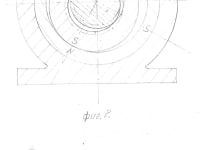A drive unit comprising a two part-electric motor and a gear box coupled thereto is known. Gear box that is needed to reduce the output speed and thereby increase the torque. A disadvantage of the known drive unit is that it results in substantial costs, such as the gear box and its coupling to the motor exceeds two and more times the value of the motor itself. Furthermore, the presence of additional knots and details leads to the appearance of gaps, unevenness and noise at work, with an increase in details reducing the security of the product itself.
This is avoided by the proposed cyclo motor. In cyclo motor we have a unique combination of functions of the motor and gear box in one. The construction is as follows:-There is a stator packet with four poles 2 in the corps 1. In the stator packet 2 houses a second stator packet with two poles 3 connected by an oldham coupling to the corps 1, therefore it cannot rotate around its axis, but only a plane motion. In the second stator packet 3 there are tree coils at 120°-as an asynchronous motor with two poles. In the second stator packet with two poles 3 there is formed a cycloid wheel with internal teeth. In the rotor 4 there is formed a cycloid wheel with external teeth engaged with the internal teeth of second stator packet 3. The rotor 4 is housed in the corps 1 and accordingly rotates at rate reduced as many times as the cycloid gear ratio. With a difference in teeth Z2-Z1=1 this is equal of teeth Z1 formed in the rotor 4. The action of the cyclo motor is as follows: In the case of rotating magnetic fields shown on Figure 1, the indentical poles of the stator packet 2 and the stator packet 3 will be repelled and the pointers will be drawn. As a consequence, the cycloid wheel with internal teeth formed in the stator packet 3 will be engaged with the external teeth formed in the rotor 4.
Provided that the stator packet 2 feeds a current at twice the frequency of that supplied to the stator packet with two poles 3, the magnetic fields will turn at the same speed and in a subsequent time (Figure 2) other tooth of the cycloid wheel formed in the stator packet 3 will engage with another tooth of the cycloid wheel formed in the rotor 4. As a result, the rotor 4 rotates.
The second stator packet 3 cannot rotate, but only a plane motion within the tooth height of the cycloid wheel since it is connected with an oldham coupling to the corps 1. Output speed are reduced respectively as many times relative to the speed of magnetic fields as the ratio of the cycloid gear. Thanks its new principle, the cyclo motor has much smaller mass and dimensions with all known drive modules and allowing a big gear ratio in one stage which makes it suitable for use in robotics, winches, portable tools, communication and medical equipment. There is an eco effect due to the use of fewer natural resources (materials and energy).
Like this entry?
-
About the Entrant
- Name:Georgi Kuchukov
- Type of entry:individual
- Patent status:pending





